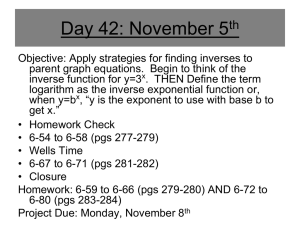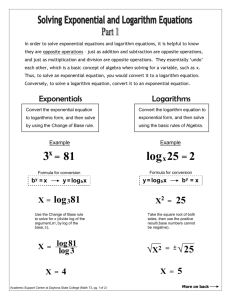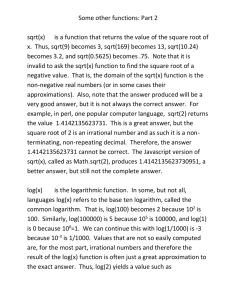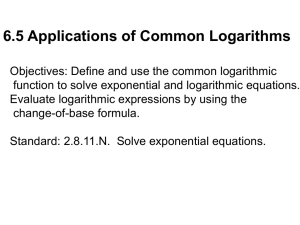Lesson 21: The Graph of the Natural Logarithm Function
advertisement
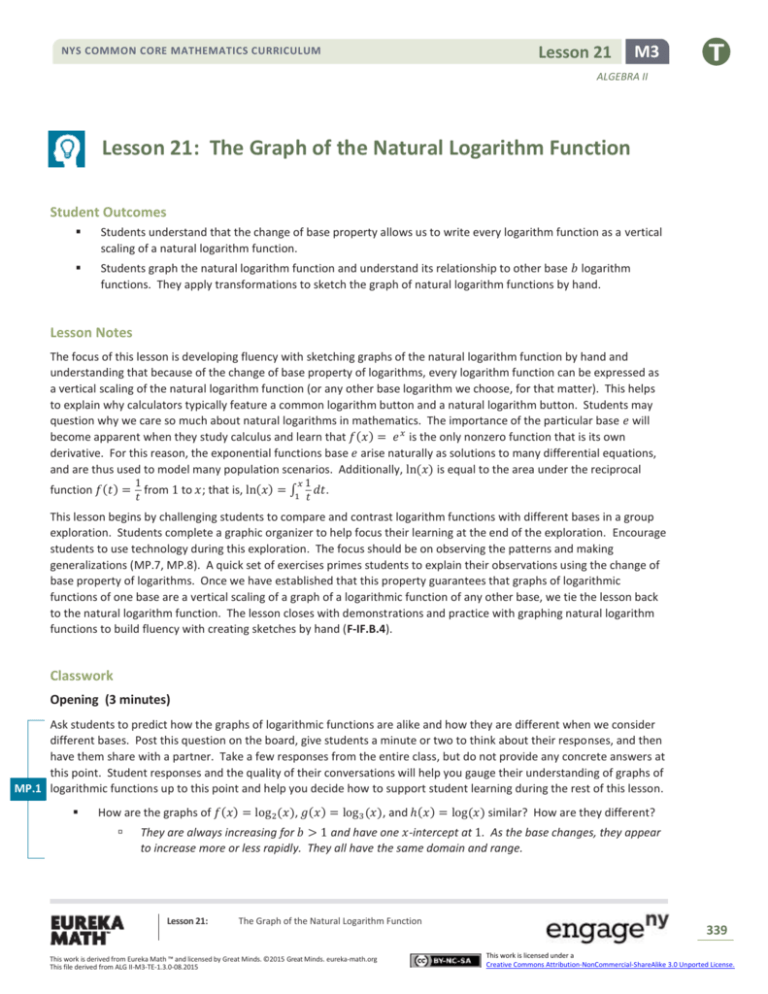
NYS COMMON CORE MATHEMATICS CURRICULUM
Lesson 21
M3
ALGEBRA II
Lesson 21: The Graph of the Natural Logarithm Function
Student Outcomes
Students understand that the change of base property allows us to write every logarithm function as a vertical
scaling of a natural logarithm function.
Students graph the natural logarithm function and understand its relationship to other base 𝑏 logarithm
functions. They apply transformations to sketch the graph of natural logarithm functions by hand.
Lesson Notes
The focus of this lesson is developing fluency with sketching graphs of the natural logarithm function by hand and
understanding that because of the change of base property of logarithms, every logarithm function can be expressed as
a vertical scaling of the natural logarithm function (or any other base logarithm we choose, for that matter). This helps
to explain why calculators typically feature a common logarithm button and a natural logarithm button. Students may
question why we care so much about natural logarithms in mathematics. The importance of the particular base 𝑒 will
become apparent when they study calculus and learn that 𝑓(𝑥) = 𝑒 𝑥 is the only nonzero function that is its own
derivative. For this reason, the exponential functions base 𝑒 arise naturally as solutions to many differential equations,
and are thus used to model many population scenarios. Additionally, ln(𝑥) is equal to the area under the reciprocal
function 𝑓(𝑡) =
𝑥1
1
from 1 to 𝑥; that is, ln(𝑥) = ∫1 𝑑𝑡.
𝑡
𝑡
This lesson begins by challenging students to compare and contrast logarithm functions with different bases in a group
exploration. Students complete a graphic organizer to help focus their learning at the end of the exploration. Encourage
students to use technology during this exploration. The focus should be on observing the patterns and making
generalizations (MP.7, MP.8). A quick set of exercises primes students to explain their observations using the change of
base property of logarithms. Once we have established that this property guarantees that graphs of logarithmic
functions of one base are a vertical scaling of a graph of a logarithmic function of any other base, we tie the lesson back
to the natural logarithm function. The lesson closes with demonstrations and practice with graphing natural logarithm
functions to build fluency with creating sketches by hand (F-IF.B.4).
Classwork
Opening (3 minutes)
Ask students to predict how the graphs of logarithmic functions are alike and how they are different when we consider
different bases. Post this question on the board, give students a minute or two to think about their responses, and then
have them share with a partner. Take a few responses from the entire class, but do not provide any concrete answers at
this point. Student responses and the quality of their conversations will help you gauge their understanding of graphs of
MP.1 logarithmic functions up to this point and help you decide how to support student learning during the rest of this lesson.
How are the graphs of 𝑓(𝑥) = log 2 (𝑥), 𝑔(𝑥) = log 3 (𝑥), and ℎ(𝑥) = log(𝑥) similar? How are they different?
They are always increasing for 𝑏 > 1 and have one 𝑥-intercept at 1. As the base changes, they appear
to increase more or less rapidly. They all have the same domain and range.
Lesson 21:
The Graph of the Natural Logarithm Function
This work is derived from Eureka Math ™ and licensed by Great Minds. ©2015 Great Minds. eureka-math.org
This file derived from ALG II-M3-TE-1.3.0-08.2015
339
This work is licensed under a
Creative Commons Attribution-NonCommercial-ShareAlike 3.0 Unported License.
Lesson 21
NYS COMMON CORE MATHEMATICS CURRICULUM
M3
ALGEBRA II
Exploratory Challenge (15 minutes)
Have students work in groups of 4–5. Each group will need the student materials for
this lesson, chart paper or personal white boards, and markers, and each student or
pair of students needs access to graphing technology such as a graphing calculator.
Have each student select at least one base value from the following list:
𝑏={
Scaffolding:
1 1
, , 2, 5, 20, 100}. Using a graphing calculator or other graphing technology,
10 2
students should independently explore how their selected base-𝑏 logarithm function’s
graph compares to the graph of the common logarithm function 𝑓(𝑥) = log(𝑥).
Next, have them describe what they observed in writing and report it to their group
members. As a group, students then categorize their findings based on the value of 𝑏
and record their observations on chart paper. Have each group present their findings
to the entire class. As you debrief this exploration as a whole class, focus on clarifying
student language in their descriptions and encourage students to revise their written
descriptions to further clarify what they wrote. Student work should be similar to the
sample responses shown below.
Exploratory Challenge
Your task is to compare graphs of base 𝒃 logarithm functions to the graph of the common
logarithm function 𝒇(𝒙) = 𝐥𝐨𝐠(𝒙) and summarize your results with your group. Recall that
the base of the common logarithm function is 𝟏𝟎. A graph of 𝒇 is provided below.
a.
Select at least one base value from this list:
𝟏 𝟏
, , 𝟐, 𝟓, 𝟐𝟎, 𝟏𝟎𝟎. Write a
𝟏𝟎 𝟐
function in the form 𝒈(𝒙) = 𝐥𝐨𝐠 𝒃 (𝒙) for your selected base value, 𝒃.
Students should use one of the numbers from the list to write their function.
The sample solutions will use 𝒈(𝒙) = 𝐥𝐨𝐠 𝟏(𝒙).
For English language learners,
the graphic organizer provides
some scaffolding, but sentence
frames may also help students
respond to part (c) in this
exploration. For example,
“Compared to the graph of 𝑓,
the graph of my function was
______.”
OR
“My function’s graph was a
____________ transformation
of the graph of 𝑓.”
For advanced learners, rather
than provide the explicit steps
listed in the Exploratory
Challenge, present the
problem on the board, give
them technology and chart
paper, and start them on the
group presentation.
𝟐
b.
Graph the functions 𝒇 and 𝒈 in the same viewing window using a graphing calculator or other graphing
application, and then add a sketch of the graph of 𝒈 to the graph of 𝒇 shown below.
The graph of 𝒇(𝒙) = 𝐥𝐨𝐠(𝒙) is shown in blue, and the graph of 𝒈(𝒙) = 𝐥𝐨𝐠 𝟏 (𝒙) is shown in green.
𝟐
MP.8
c.
Describe how the graph of 𝒈 for the base you selected compares to the graph of 𝒇(𝒙) = 𝐥𝐨𝐠(𝒙).
Answers will vary depending on the base selected. For example, when the base is 𝟐𝟎, the graph of 𝒈 appears
to be a vertical scaling of the common logarithm function by a factor less than 𝟏.
Lesson 21:
The Graph of the Natural Logarithm Function
This work is derived from Eureka Math ™ and licensed by Great Minds. ©2015 Great Minds. eureka-math.org
This file derived from ALG II-M3-TE-1.3.0-08.2015
340
This work is licensed under a
Creative Commons Attribution-NonCommercial-ShareAlike 3.0 Unported License.
Lesson 21
NYS COMMON CORE MATHEMATICS CURRICULUM
M3
ALGEBRA II
d.
Share your results with your group and record observations on the graphic organizer below. Prepare a group
presentation that summarizes the group’s findings.
How does the graph of 𝒈(𝒙) = 𝐥𝐨𝐠 𝒃(𝒙) compare to the graph of 𝒇(𝒙) = 𝐥𝐨𝐠(𝒙) for various values of 𝒃?
𝟎<𝒃<𝟏
The function 𝒈 is decreasing. Its graph is a reflection about the horizontal axis of the
graph of a logarithmic function whose base is the reciprocal of 𝒃.
𝟏 < 𝒃 < 𝟏𝟎
When 𝒃 is between 𝟏 and 𝟏𝟎, the graph of 𝒈 appears to be a vertical scaling of the
graph of 𝒇 by a factor greater than 𝟏. As 𝒃 gets closer to 𝟏𝟎, the graph of 𝒈 gets closer
to the graph of 𝒇 and appears less steep.
𝒃 > 𝟏𝟎
When 𝒃 is greater than 𝟏𝟎, the graph of 𝒈 appears to be a vertical scaling of the graph
of 𝒇 by a factor between 𝟎 and 𝟏. As 𝒃 grows, the graph of 𝒈 grows at a slower rate
and appears to move closer to the horizontal axis than the graphs of logarithmic
functions whose bases are closest to 𝟏𝟎.
MP.8
The graphs of logarithmic functions with several of the bases listed is shown below.
As the groups work through this exploration, be sure to guide them to appropriate conclusions without explicitly telling
them answers. After or during the group presentations, ask questions such as the ones listed below to clarify student
understanding.
MP.3
&
MP.7
Why are the functions decreasing when 𝑏 is between 0 and 1?
1
2
1
2
𝑦
Consider 𝑏 = . Then, 𝑦 = log 𝑏 (𝑥) = log 1 (𝑥), and ( ) = 𝑥. If 𝑥 > 1, then 𝑦 < 0. As 𝑥 increases,
2
𝑦 becomes larger in magnitude while staying negative, so 𝑦 decreases. Thus, the function is
decreasing.
The exponential function for bases between 0 and 1 is a decreasing function, so when we have a
logarithmic function with these bases, the range values will also decrease as the domain values
increase.
Lesson 21:
The Graph of the Natural Logarithm Function
This work is derived from Eureka Math ™ and licensed by Great Minds. ©2015 Great Minds. eureka-math.org
This file derived from ALG II-M3-TE-1.3.0-08.2015
341
This work is licensed under a
Creative Commons Attribution-NonCommercial-ShareAlike 3.0 Unported License.
Lesson 21
NYS COMMON CORE MATHEMATICS CURRICULUM
M3
ALGEBRA II
How does the graph of 𝑦 = log 𝑏 (𝑥) relate to the graph of 𝑦 = log 1 (𝑥)? Explain why this relationship exists.
𝑏
The graphs appear to be reflections of one another about the horizontal axis. The graphs of 𝑦 = 𝑏 𝑥
1
𝑏
𝑥
1
𝑏
𝑥
and 𝑦 = ( ) are reflections about the vertical axis because ( ) = 𝑏 −𝑥 . Thus, when we exchange the
domain and range values to form the related logarithmic functions, they will also be reflections of one
another but about the horizontal axis.
Why do smaller bases 𝑏 > 1 produce steeper graphs and larger bases produce flatter graphs?
MP.3
&
MP.7
Where would the graph of 𝑦 = ln(𝑥) sit in relation to these graphs? How do you know?
Logarithmic functions with a smaller base grow at a faster rate, making the graph steeper. For
example, log 2 (64) = 6, log 4 (64) = 3, and log 8 (64) = 2. The same input of 64 produces a smaller
output as the size of the base increases.
The graph of 𝑦 = ln(𝑥) would be in between the two graphs of 𝑦 = log 2 (𝑥) and 𝑦 = log 5 (𝑥) because
𝑒 is a number between 2 and 5.
The graphs of these functions appear to be vertical scalings of each other. How could we prove that this is
true?
We would have to show that we can rewrite each function as a constant multiple of another
logarithmic function.
Check to make sure each student has recorded appropriate information in the graphic organizer in part (d) before
moving on. Post the group presentations on the board for reference during the rest of this lesson.
Exercise 1 (5 minutes)
Announce that now we will explore how all these graphs are related using a property of logarithms. Students should be
able to complete this exercise quickly. Some students may already start to understand why the graphs appeared the
way they did in the Exploratory Challenge as they work through these exercises.
Exercise 1
Use the change of base property to rewrite each logarithmic function in terms of the common logarithm function.
Base 𝒃
Base 𝟏𝟎 (Common logarithm)
𝒈𝟏 (𝒙) = 𝐥𝐨𝐠 𝟏(𝒙)
𝒈𝟏 (𝒙) =
𝐥𝐨𝐠(𝒙)
𝐥𝐨𝐠(𝟏𝟒)
𝒈𝟐 (𝒙) = 𝐥𝐨𝐠 𝟏(𝒙)
𝒈𝟐 (𝒙) =
𝐥𝐨𝐠(𝒙)
𝐥𝐨𝐠(𝟏𝟐)
𝒈𝟑 (𝒙) = 𝐥𝐨𝐠 𝟐(𝒙)
𝒈𝟑 (𝒙) =
𝐥𝐨𝐠(𝒙)
𝐥𝐨𝐠(𝟐)
𝒈𝟒 (𝒙) = 𝐥𝐨𝐠 𝟓(𝒙)
𝒈𝟒 (𝒙) =
𝐥𝐨𝐠(𝒙)
𝐥𝐨𝐠(𝟓)
𝒈𝟓 (𝒙) = 𝐥𝐨𝐠 𝟐𝟎 (𝒙)
𝒈𝟓 (𝒙) =
𝐥𝐨𝐠(𝒙)
𝐥𝐨𝐠(𝟐𝟎)
𝒈𝟔 (𝒙) = 𝐥𝐨𝐠 𝟏𝟎𝟎(𝒙)
𝒈𝟔 (𝒙) =
𝐥𝐨𝐠(𝒙)
𝐥𝐨𝐠(𝟏𝟎𝟎)
𝟒
𝟐
Lesson 21:
The Graph of the Natural Logarithm Function
This work is derived from Eureka Math ™ and licensed by Great Minds. ©2015 Great Minds. eureka-math.org
This file derived from ALG II-M3-TE-1.3.0-08.2015
342
This work is licensed under a
Creative Commons Attribution-NonCommercial-ShareAlike 3.0 Unported License.
Lesson 21
NYS COMMON CORE MATHEMATICS CURRICULUM
M3
ALGEBRA II
Discussion (5 minutes)
Lead a discussion to help students observe that each function in base 10 is divided by a constant (which is the same as
multiplying by the reciprocal of that number). Have students explore the values of the constants using their calculators,
and have them make sense of why the graphs appear the way they do compared to the graph of the common logarithm
function. For example, log(2) ≈ 0.69. When dividing by a number between 0 and 1, you get the same result as
1
2
1
4
multiplying by its reciprocal, which is a number greater than 1. The values of log ( ) and log ( ) are negative, which
explains why the graphs of functions 𝑔1 and 𝑔2 are vertical scalings and reflections of the graph of the common
logarithm function. When the base is greater than 10, as is the case with functions 𝑔5 and 𝑔6 , we are dividing by a
number greater than 1, which is the same as multiplying by a number between 0 and 1, which compresses the graph
vertically.
How do the functions from Exercise 1 that you wrote in base 10 compare to the function 𝑓(𝑥) = log(𝑥)?
They are a constant multiple of the function 𝑓. For example, log(100) = 2, so the function
𝑔6 (𝑥) =
log(𝑥)
1
could also be written as 𝑔(𝑥) = log(𝑥).
log(100)
2
Approximate the values of the constants in the functions from Exercise 1. How do those values help to explain
why the graphs are a vertical stretch of the common logarithm function when the base is between 1 and 10,
and a vertical compression when the base is greater than 10? Why are the functions decreasing when the
base is between 0 and 1?
When the base is between 1 and 10, the common logarithms are between 0 and 1. Dividing by a
number between 0 and 1 is the same as multiplying by a number larger than 1, which will scale the
graph vertically by a factor greater than 1. For bases greater than 10, the common logarithm function
is multiplied by a number between 0 and 1. The functions decrease when the base is between 0 and 1
because the common logarithms of those numbers are less than 0.
Next, revisit the question posed earlier regarding the graph of 𝑦 = ln(𝑥), the natural logarithm function, as a way to
transition into the last portion of this lesson.
Where would the graph of 𝑦 = ln(𝑥) sit in relation to these graphs? How do you know?
The graph of 𝑦 = ln(𝑥) would lie in between the graphs of 𝑦 = log 2 (𝑥) and 𝑦 = log 5 (𝑥) because 𝑒 is a
number between 2 and 5.
Lesson 21:
The Graph of the Natural Logarithm Function
This work is derived from Eureka Math ™ and licensed by Great Minds. ©2015 Great Minds. eureka-math.org
This file derived from ALG II-M3-TE-1.3.0-08.2015
343
This work is licensed under a
Creative Commons Attribution-NonCommercial-ShareAlike 3.0 Unported License.
Lesson 21
NYS COMMON CORE MATHEMATICS CURRICULUM
M3
ALGEBRA II
Example 1 (5 minutes): The Graph of the Natural Logarithm Function 𝒇(𝒙) = 𝐥𝐧(𝒙)
The example that follows demonstrates how to sketch the graph of the natural logarithm function by hand and shows
more precisely where it sits in relation to base-2 and base-10 logarithm functions.
Example 1: The Graph of the Natural Logarithm Function 𝒇(𝒙) = 𝐥𝐧(𝒙)
Graph the natural logarithm function below to demonstrate where it sits in relation to the graphs of the base-𝟐 and base𝟏𝟎 logarithm functions.
The graphs are not labeled in the student file. You can question students about this to informally assess their
understanding at this point.
Which graph is 𝑦 = log 2 (𝑥), and which one is 𝑦 = log(𝑥)? How can you tell?
Since the base 2 is smaller, the logarithm function base 2 grows more quickly than the base-10
logarithm function, so the green graph is the graph of 𝑦 = log 2 (𝑥). You can also verify which graph is
which by identifying a few points and substituting them into the equations to see which is true. For
example, the blue graph appears to contain the point (1, 10). Since 1 = log(10), the blue graph
represents the common logarithm function.
Remind students that 𝑒 ≈ 2.718. Create a table of values like the one shown below and then plot these points. Connect
the points with a smooth curve. When students are sketching by hand in the next example, have them plot fewer points,
perhaps where the 𝑦-values are integers only.
𝒙
𝒇(𝒙) = 𝐥𝐧(𝒙)
1
≈ 0.369
𝑒
−1
1
0
𝑒 0.5 ≈ 1.649
0.5
𝑒 1 ≈ 2.718
1
𝑒
1.5
≈ 4.482
𝑒 2 ≈ 7.389
Lesson 21:
1.5
2
The Graph of the Natural Logarithm Function
This work is derived from Eureka Math ™ and licensed by Great Minds. ©2015 Great Minds. eureka-math.org
This file derived from ALG II-M3-TE-1.3.0-08.2015
344
This work is licensed under a
Creative Commons Attribution-NonCommercial-ShareAlike 3.0 Unported License.
Lesson 21
NYS COMMON CORE MATHEMATICS CURRICULUM
M3
ALGEBRA II
Example 2 (5 minutes)
In this example, part (a) models how to sketch graphs by applying transformations. Then, show students in part (b) how
to rewrite the function as a natural logarithm function, and sketch the graph by applying transformations of the graph of
𝑓(𝑥) = ln(𝑥). Model the transformations in stages. First, sketch the graph of 𝑦 = ln(𝑥); next, sketch a second graph
applying the first transformation; finally, sketch a graph applying the last transformation to the second graph you made.
Example 2
Graph each function by applying transformations of the graphs of the natural logarithm function.
a.
𝒇(𝒙) = 𝟑 𝐥𝐧(𝒙 − 𝟏)
The graph of 𝒇 is the graph of 𝒚 = 𝐥𝐧(𝒙) shifted horizontally 𝟏 unit to the right, stretched vertically by a
factor of 𝟑.
b.
𝒈(𝒙) = 𝐥𝐨𝐠 𝟔(𝒙) − 𝟐
First, write 𝒈 as a natural logarithm function.
𝒈(𝒙) =
Since
𝟏
𝐥𝐧(𝟔)
𝐥𝐧(𝒙)
−𝟐
𝐥𝐧(𝟔)
≈ 𝟎. 𝟓𝟓𝟖, the graph of 𝒈 will be the graph of 𝒚 = 𝐥𝐧(𝒙) scaled vertically by a factor of
approximately 𝟎. 𝟓𝟔 and translated down 𝟐 units.
Lesson 21:
The Graph of the Natural Logarithm Function
This work is derived from Eureka Math ™ and licensed by Great Minds. ©2015 Great Minds. eureka-math.org
This file derived from ALG II-M3-TE-1.3.0-08.2015
345
This work is licensed under a
Creative Commons Attribution-NonCommercial-ShareAlike 3.0 Unported License.
NYS COMMON CORE MATHEMATICS CURRICULUM
Lesson 21
M3
ALGEBRA II
Closing (2 minutes)
Have students summarize what they have learned in this lesson by revisiting the question from the Opening. Students
should revise their initial responses and either discuss their answers with a partner or write a brief individual reflection.
The responses should be similar to what is listed in the Lesson Summary.
How are the graphs of logarithmic functions with different bases alike? How are they different?
They have the same 𝑥-intercept 1, and when the base is greater than 1, the functions are increasing.
They all have the same domain and range. They are different because as the base changes, the
steepness of the graph of the function changes. Logarithmic functions with larger bases grow at slower
rates.
How does the change of base property guarantee that every logarithmic function could be expressed in the
form 𝑓(𝑥) = 𝑘 + 𝑎 ln(𝑥 − ℎ)?
The change of base property guarantees that we can convert any logarithmic expression in base 𝑏 to a
natural logarithmic expression where the denominator of the expression is constant.
Exit Ticket (5 minutes)
Lesson 21:
The Graph of the Natural Logarithm Function
This work is derived from Eureka Math ™ and licensed by Great Minds. ©2015 Great Minds. eureka-math.org
This file derived from ALG II-M3-TE-1.3.0-08.2015
346
This work is licensed under a
Creative Commons Attribution-NonCommercial-ShareAlike 3.0 Unported License.
Lesson 21
NYS COMMON CORE MATHEMATICS CURRICULUM
M3
ALGEBRA II
Name
Date
Lesson 21: The Graph of the Natural Logarithm Function
Exit Ticket
1.
2.
a.
Describe the graph of 𝑔(𝑥) = 2 − ln(𝑥 + 3) as a transformation of the graph of 𝑓(𝑥) = ln(𝑥).
b.
Sketch the graphs of 𝑓 and 𝑔 by hand.
Explain where the graph of 𝑔(𝑥) = log 3 (2𝑥) would sit in relation to the graph of 𝑓(𝑥) = ln(𝑥). Justify your answer
using properties of logarithms and your knowledge of transformations of graph of functions.
Lesson 21:
The Graph of the Natural Logarithm Function
This work is derived from Eureka Math ™ and licensed by Great Minds. ©2015 Great Minds. eureka-math.org
This file derived from ALG II-M3-TE-1.3.0-08.2015
347
This work is licensed under a
Creative Commons Attribution-NonCommercial-ShareAlike 3.0 Unported License.
Lesson 21
NYS COMMON CORE MATHEMATICS CURRICULUM
M3
ALGEBRA II
Exit Ticket Sample Solutions
1.
a.
Describe the graph of 𝒈(𝒙) = 𝟐 − 𝐥𝐧(𝒙 + 𝟑) as a transformation of the graph of 𝒇(𝒙) = 𝐥𝐧(𝒙).
The graph of 𝒈 is the graph of 𝒇 translated 𝟑 units to the left, reflected about the horizontal axis, and
translated up 𝟐 units.
b.
2.
Sketch the graphs of 𝒇 and 𝒈 by hand.
Explain where the graph of 𝒈(𝒙) = 𝐥𝐨𝐠 𝟑(𝟐𝒙) would sit in relation to the graph of 𝒇(𝒙) = 𝐥𝐧(𝒙). Justify your answer
using properties of logarithms and your knowledge of transformations of graph of functions.
Since 𝐥𝐨𝐠 𝟑(𝟐𝒙) =
𝐥𝐧(𝟐𝒙) 𝐥 𝐧(𝟐) 𝐥 𝐧(𝒙)
= ( ) + ( ), the graph of 𝒈 would be a vertical shift and a vertical scaling by a factor
𝐥𝐧(𝟑)
𝐥𝐧 𝟑
𝐥𝐧 𝟑
greater than 𝟏 of the graph of 𝒇. The graph of 𝒈 will lie vertically above the graph of 𝒇.
Problem Set Sample Solutions
1.
Rewrite each logarithmic function as a natural logarithm function.
a.
𝒇(𝒙) = 𝐥𝐨𝐠 𝟓(𝒙)
𝒇(𝒙) =
b.
𝐥𝐧(𝒙)
𝐥𝐧(𝟓)
𝒇(𝒙) = 𝐥𝐨𝐠 𝟐(𝒙 − 𝟑)
𝒇(𝒙) =
𝐥𝐧(𝒙 − 𝟑)
𝐥𝐧(𝟐)
Lesson 21:
The Graph of the Natural Logarithm Function
This work is derived from Eureka Math ™ and licensed by Great Minds. ©2015 Great Minds. eureka-math.org
This file derived from ALG II-M3-TE-1.3.0-08.2015
348
This work is licensed under a
Creative Commons Attribution-NonCommercial-ShareAlike 3.0 Unported License.
Lesson 21
NYS COMMON CORE MATHEMATICS CURRICULUM
M3
ALGEBRA II
c.
𝒙
𝟑
𝒇(𝒙) = 𝐥𝐨𝐠 𝟐 ( )
𝒇(𝒙) =
d.
𝐥𝐧(𝒙) 𝐥𝐧(𝟑)
−
𝐥𝐧(𝟐) 𝐥𝐧(𝟐)
𝒇(𝒙) = 𝟑 − 𝐥𝐨𝐠(𝒙)
𝒇(𝒙) = 𝟑 −
e.
𝒇(𝒙) = 𝟐𝐥𝐨𝐠(𝒙 + 𝟑)
𝒇(𝒙) =
f.
𝟐
𝐥𝐧(𝒙 + 𝟑)
𝐥𝐧(𝟏𝟎)
𝒇(𝒙) = 𝐥𝐨𝐠 𝟓(𝟐𝟓𝒙)
𝒇(𝒙) = 𝟐 +
2.
𝐥𝐧(𝒙)
𝐥𝐧(𝟏𝟎)
𝐥𝐧(𝒙)
𝐥𝐧(𝟓)
Describe each function as a transformation of the natural logarithm function 𝒇(𝒙) = 𝐥𝐧(𝒙).
a.
𝒈(𝒙) = 𝟑𝐥𝐧(𝒙 + 𝟐)
The graph of 𝒈 is the graph of 𝒇 translated 𝟐 units to the left and scaled vertically by a factor of 𝟑.
b.
𝒈(𝒙) = −𝐥𝐧(𝟏 − 𝒙)
The graph of 𝒈 is the graph of 𝒇 translated 𝟏 unit to the right, reflected about 𝒙 = 𝟏, and then reflected about
the horizontal axis.
c.
𝒈(𝒙) = 𝟐 + 𝐥𝐧(𝒆𝟐 𝒙)
The graph of 𝒈 is the graph of 𝒇 translated up 𝟒 units.
d.
𝒈(𝒙) = 𝐥𝐨𝐠 𝟓(𝟐𝟓𝒙)
The graph of 𝒈 is the graph of 𝒇 translated up 𝟐 units and scaled vertically by a factor of
Lesson 21:
The Graph of the Natural Logarithm Function
This work is derived from Eureka Math ™ and licensed by Great Minds. ©2015 Great Minds. eureka-math.org
This file derived from ALG II-M3-TE-1.3.0-08.2015
𝟏
.
𝐥𝐧(𝟓)
349
This work is licensed under a
Creative Commons Attribution-NonCommercial-ShareAlike 3.0 Unported License.
NYS COMMON CORE MATHEMATICS CURRICULUM
Lesson 21
M3
ALGEBRA II
3.
Sketch the graphs of each function in Problem 2, and identify the key features including intercepts, intervals where
the function is increasing or decreasing, and the vertical asymptote.
a.
The equation of the vertical asymptote is 𝒙 = −𝟐. The 𝒙-intercept is −𝟏. The function is increasing for all
𝒙 > −𝟐. The 𝒚-intercept is approximately 𝟐. 𝟎𝟕𝟗.
b.
The equation of the vertical asymptote is 𝒙 = 𝟏. The 𝒙-intercept is 𝟎. The function is increasing for all 𝒙 < 𝟏.
The 𝒚-intercept is 𝟎.
Lesson 21:
The Graph of the Natural Logarithm Function
This work is derived from Eureka Math ™ and licensed by Great Minds. ©2015 Great Minds. eureka-math.org
This file derived from ALG II-M3-TE-1.3.0-08.2015
350
This work is licensed under a
Creative Commons Attribution-NonCommercial-ShareAlike 3.0 Unported License.
NYS COMMON CORE MATHEMATICS CURRICULUM
Lesson 21
M3
ALGEBRA II
c.
The equation of the vertical asymptote is 𝒙 = 𝟎. The 𝒙-intercept is approximately 𝟎. 𝟎𝟏𝟖. The function is
increasing for all 𝒙 > 𝟎.
d.
The equation of the vertical asymptote is 𝒙 = 𝟎. The 𝒙-intercept is 𝟎. 𝟎𝟒 . The function is increasing for all
𝒙 > 𝟎.
Lesson 21:
The Graph of the Natural Logarithm Function
This work is derived from Eureka Math ™ and licensed by Great Minds. ©2015 Great Minds. eureka-math.org
This file derived from ALG II-M3-TE-1.3.0-08.2015
351
This work is licensed under a
Creative Commons Attribution-NonCommercial-ShareAlike 3.0 Unported License.
Lesson 21
NYS COMMON CORE MATHEMATICS CURRICULUM
M3
ALGEBRA II
4.
Solve the equation 𝟏 − 𝒆𝒙−𝟏 = 𝐥𝐧(𝒙) graphically, without using a calculator.
It appears that the two graphs intersect at the point (𝟏, 𝟎). Checking, we see that 𝟏 − 𝒆𝟏−𝟏 = 𝟏 − 𝟏 = 𝟎 , and we
know that 𝐥𝐧(𝟏) = 𝟎, so when 𝒙 = 𝟎, we have 𝟏 − 𝒆𝒙−𝟏 = 𝐥𝐧(𝒙). Thus 𝟎 is a solution to this equation. From the
graph, it is the only solution.
5.
Use a graphical approach to explain why the equation 𝐥𝐨𝐠(𝒙) = 𝐥𝐧(𝒙) has only one solution.
The graphs intersect in only one point (𝟏, 𝟎), so the equation has only one solution.
Lesson 21:
The Graph of the Natural Logarithm Function
This work is derived from Eureka Math ™ and licensed by Great Minds. ©2015 Great Minds. eureka-math.org
This file derived from ALG II-M3-TE-1.3.0-08.2015
352
This work is licensed under a
Creative Commons Attribution-NonCommercial-ShareAlike 3.0 Unported License.
Lesson 21
NYS COMMON CORE MATHEMATICS CURRICULUM
M3
ALGEBRA II
6.
Juliet tried to solve this equation as shown below using the change of base property and concluded there is no
solution because 𝐥𝐧(𝟏𝟎) ≠ 𝟏. Construct an argument to support or refute her reasoning.
𝐥𝐨𝐠(𝒙) = 𝐥𝐧(𝒙)
𝐥𝐧(𝒙)
= 𝐥𝐧(𝒙)
𝐥𝐧(𝟏𝟎)
𝐥𝐧(𝒙)
𝟏
𝟏
= (𝐥𝐧(𝒙))
(
)
𝐥𝐧(𝟏𝟎) 𝐥𝐧(𝒙)
𝐥𝐧(𝒙)
MP.3
𝟏
=𝟏
𝐥𝐧(𝟏𝟎)
Juliet’s approach works as long as 𝐥𝐧(𝒙) ≠ 𝟎, which occurs when 𝒙 = 𝟏. The solution to this equation is 𝟏. When
you divide both sides of an equation by an algebraic expression, you need to impose restrictions so that you are not
dividing by 𝟎. In this case, Juliet divided by 𝐥𝐧(𝒙), which is not valid if 𝒙 = 𝟏. This division caused the equation in
the third and final lines of her solution to have no solution; however, the original equation is true when 𝒙 is 𝟏.
7.
Consider the function 𝒇 given by 𝒇(𝒙) = 𝐥𝐨𝐠 𝒙 (𝟏𝟎𝟎) for 𝒙 > 𝟎 and 𝒙 ≠ 𝟏.
a.
What are the values of 𝒇(𝟏𝟎𝟎), 𝒇(𝟏𝟎), and 𝒇(√𝟏𝟎)?
𝒇(𝟏𝟎𝟎) = 𝟏, 𝒇(𝟏𝟎) = 𝟐, 𝒇(√𝟏𝟎) = 𝟒
b.
Why is the value 𝟏 excluded from the domain of this function?
The value 𝟏 is excluded from the domain because 𝟏 is not a base of an exponential function since it would
produce the graph of a constant function. Since logarithmic functions by definition are related to exponential
functions, we cannot have a logarithm with base 𝟏.
c.
Find a value 𝒙 so that 𝒇(𝒙) = 𝟎. 𝟓.
𝐥𝐨𝐠 𝒙(𝟏𝟎𝟎) = 𝟎. 𝟓
𝒙𝟎.𝟓 = 𝟏𝟎𝟎
𝒙 = 𝟏𝟎, 𝟎𝟎𝟎
The value of 𝒙 that satisfies this equation is 𝟏𝟎, 𝟎𝟎𝟎.
d.
Find a value 𝒘 so that 𝒇(𝒘) = −𝟏.
The value of 𝒘 that satisfies this equation is
e.
𝟏
.
𝟏𝟎𝟎
Sketch a graph of 𝒚 = 𝐥𝐨𝐠 𝒙 (𝟏𝟎𝟎) for
𝒙 > 𝟎 and 𝒙 ≠ 𝟏.
Lesson 21:
The Graph of the Natural Logarithm Function
This work is derived from Eureka Math ™ and licensed by Great Minds. ©2015 Great Minds. eureka-math.org
This file derived from ALG II-M3-TE-1.3.0-08.2015
353
This work is licensed under a
Creative Commons Attribution-NonCommercial-ShareAlike 3.0 Unported License.


